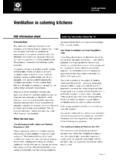Transcription of GOOD PRACTICE GUIDE AN INTRODUCTION TO …
1 good PRACTICE GUIDEAN INTRODUCTION TO MULTIPHASE FLOW INTRODUCTION to multiphase flow measurementContents1 What is Multiphase Flow? 22 Key Definitions 23 Flow Patterns 54 Fluid Properties 65 How to Measure Multiphase Flow 7 Separators 7 Multiphase flow meters 8 Partial Seperation 106 Installation of Multiphase Flow Meters 107 Flow Assurance Challenges 118 Summary 119 Further Reading 12 This GUIDE provides an INTRODUCTION to multiphase flow measurement. Firstly, the document covers key definitions associated with multiphase flow before moving onto multiphase flow patterns and properties. Multiphase flow measurement technologies are introduced, along with installation and flow assurance What is Multiphase Flow?Before you can attempt to measure multiphase flow it is important to understand what is actually meant by multiphase flow. You may not realise it but we encounter multiphase flow just about every single day.
2 It could be rain (liquid) falling down through the air (gas), or the bubbles (gas) in your lemonade (liquid). However, there is not much requirement to meter each individual phase in these examples. When we talk about multiphase metering, more likely than not, we mean hydrocarbon multiphase flow measurement oil, water and gas. Multiphase flow is actually a misnomer in that the oil and water are both liquid so what we really mean is multi-component flow. An everyday example of a multi-component mixture would be gin (liquid) and tonic water (liquid and gas).Multiphase (or multi-component) flow occurs in many industries including food and drink, and pharmaceutical. There has never been any real demand to meter the individual phases or components in these industries. However, in the oil & gas industry, especially as fields become more economically marginal there is growing demand to meter the individual components of oil, water and gas stream.
3 This good PRACTICE GUIDE will therefore focus on hydrocarbon multiphase flow measurement although multiphase (or multi-component) flows also exist in other Key DefinitionsMultiphase flow is different to single phase flow and has its own Mass FractionThe phase mass fraction is the mass flow rate of one component in relation to the total mass flow rate of the multiphase mixture. That is:Gas Mass Fraction = Gas Mass Flow Rate / Total Mass Flow RatePhase Volume FractionThe phase volume fraction is the volumetric flow rate of one component in relation to the total volumetric flow rate. That is:Gas Volume Fraction = Gas Volumetric Flow Rate / Total Volumetric Flow RatePhase Area FractionThe phase area fraction is the cross-sectional area occupied by one phase relative to the total cross-sectional area of the pipe at that point. The void fraction is the cross-sectional area of the pipe occupied with gas.
4 The hold-up is the cross-sectional area of the pipe occupied with is important to distinguish gas void fraction from gas volume fraction. Unfortunately they both have the same acronym, GVF, which makes it easy to confuse them. The gas volume fraction is usually larger than the gas void fraction. good PRACTICE Guide22 Key Definitions SlipThe components of a multiphase mixture travel at different velocities. Generally speaking, the velocity of the gas is much greater than the velocity of the liquid. In some production wells it takes the gas a few hours to reach the well head but it can take the liquid days to travel the same distance. This difference in velocities is known as phase slip. Slip Slip ratio How is the phase slip determined? That is the $64 million question and at this time no empirical formula exists but a couple of ways you could try are: A semi-empirical formula for a particular flow pattern1.
5 Perform laboratory or test facility experiments with known gas volume fractions, and develop a correlation for K using appropriate physical variables. It should be noted that using this method strictly only applies to the range of conditions for that particular set of experiments and should not be extrapolated outside that volume fraction (GVF), gas void fraction ( g) and slip (K) are all related to each other. Homogeneous FlowA multiphase mixture is considered to be a homogeneous flow when the liquid and gas are travelling at the same velocity K = 1. Homogeneous flow can be desirable, depending on the design of a multiphase flow meter, as it eliminates the need for slip models. Water CutWater cut is also sometimes referred to as the water to liquid ratio (WLR). It is simply, the water volume fraction of the liquid phase:Water Cut = Water Volumetric Flow Rate / Total Liquid Volumetric Flow RateAn INTRODUCTION to multiphase flow measurement3 1 Flow patterns will be covered Key Definitions RegionAn oil/water mixture can be described as being oil-continuous or water-continuous.
6 Oil-continuous flow is characterised by water droplets being surrounded by oil. Water-continuous flow is oil droplets surrounded by water. The inversion region lies between oil-continuous and water-continuous flow and is unpredictable as it can show characteristics of either oil-continuous or water-continuous flow, changing from one moment to the next. Operating in the oil/water inversion region can create difficulties for certain multiphase measurement Phase VelocityThe superficial phase velocity is the velocity the individual phase would have if it flowed alone in the pipe. By way of illustration: You have a pipe with an inside diameter of 150 mm The cross-sectional area of the pipe would be m2 The gas and liquid volumetric flow rates are 950 m3/hr and 50 m3/hr respectively This means the superficial velocities of the gas and liquid are m/s and m/s respectivelyWet GasWet gas is a multi-component mixture that mostly consists of gas with a small amount of liquid present.
7 When does multiphase flow become wet gas? That question is not as straightforward as it seems. There have been numerous debates as to the exact definition of wet gas, the good PRACTICE GUIDE ; An INTRODUCTION to Wet-Gas Flow Metering goes into the various definitions of wet gas in more detail. Some classify wet gas as being a multi-component flow with a gas volume fraction greater than 90%, for others it is when the gas volume fraction is greater than 95%, another classification involves calculating the Lockhart-Martinelli parameter, which defines the wetness of the of MeasurementIn the oil and gas industry liquids flow rates are often given in barrels per day (bbl/d) and gas flow rates are commonly measured in mmscfd (million standard cubic feet per day). As these units are different from each other it can make it difficult to get a feel for the gas volume fraction and water cut as you are not comparing like with like.
8 To enable direct comparison it might be beneficial to convert them into metric units. There are numerous different sizes of barrel and they range from 100 to 200 litres. The standard oil barrel volume is equivalent to litres. The standard part of mmscfd refers to standard pressure and temperature. This can vary depending on where in the world you are and what industry you are dealing with. The most common standard used with mmscfd in the oil & gas industry is the US standard for natural gas at 60oF ( ) and PRACTICE Guide43 Flow PatternsIn single phase flow you either have laminar or turbulent flow but in multiphase flow it is a little more complicated. How the liquid and gas is distributed within a pipe varies depending on the superficial velocities of the phases and the orientation of the Horizontal Flow PatternsThere are seven horizontal flow patterns: Stratified Stratified wavy Plug Slug Bubble Annular Mist Stratified and stratified wavy flow patterns occur at fairly low liquid and gas velocities.
9 As the gas velocity increases, or if the pipe inclines, then the interface becomes and slug are intermittent flow patterns as they have alternating regions of high and low liquid hold-up. As the liquid flow rate increases, the liquid becomes the dominant phase and the flow changes from plug into there are the distributed flow patterns, bubble, annular and mist. Bubble flow occurs at high liquid velocities where the gas bubbles are suspended in the liquid phase. Annular flow occurs at high gas velocities where the gas flow along the central core of the pipe and the liquid forms a film on the pipe wall. When the gas flow increases it will start to pick up the liquid from the pipe wall and incorporate it into the gas flow: this is called mist flow. Two-Phase Vertical Flow PatternsThere are five vertical multiphase flow patterns: Bubble Finely dispersed bubble Slug Churn AnnularAn INTRODUCTION to multiphase flow measurement5 Note: Flow maps of the type presented here will be dependent upon the fluid, temperature and pressure; they are not Flow Patterns to horizontal bubble flow, vertical bubble flow has a continuous liquid phase with dispersed gas bubbles.
10 As the gas velocity increases, the dispersed bubbles start to coalesce and form Taylor bubbles also known as slugs. Increasing gas velocity will cause irregular gas slugs and the liquid will start to rise and fall, or in other words, churn. A further increase in gas velocity will form a gas core in the pipe with the liquid forming an annulus at the pipe FlowThe horizontal and vertical flow patterns discussed in the previous two sections cover two-phase or two-component flow with only one liquid and one gas present. In multiphase flow you will have three-phases or, three-components. Having two components in the liquid phase (oil and water) can throw up further complications, particularly in horizontal flow. In stratified flow and in slug flow it is possible for the oil and water to separate meaning that there will be slip between the two liquid phases. This will make it more difficult to calculate the water cut and so flow measurement of all three phases will be more complicated.






